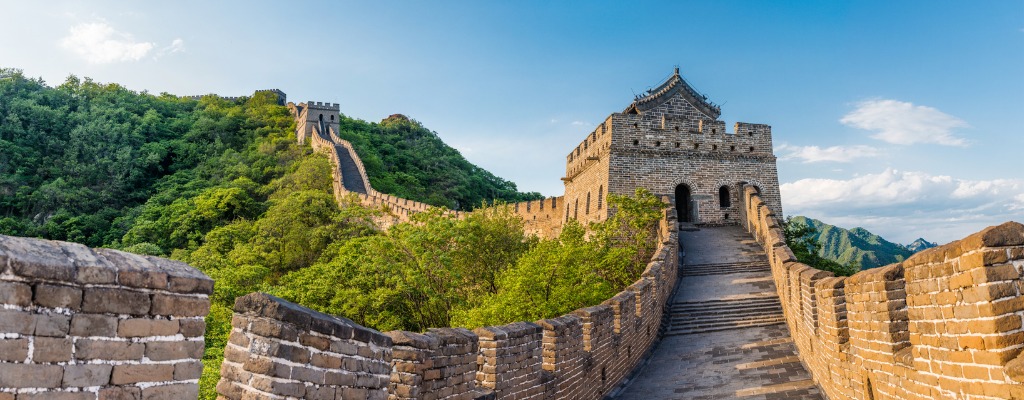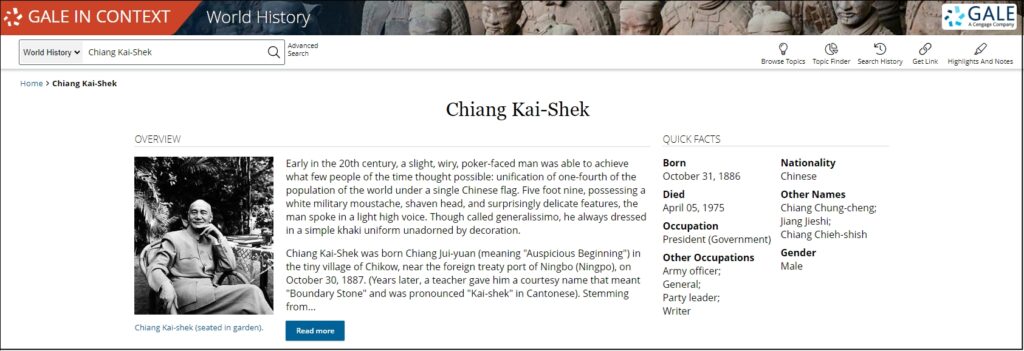| By J. Robert Parks |
China has cultivated a civilization that sees itself in historical terms, and its leaders often justify their decisions by recalling the country’s history. That history stretches over millennia, but the People’s Republic of China was only founded seventy-five years ago this week, on October 1, 1949. Educators and librarians who want to help students understand China’s recent and ancient history will find a bevy of resources in Gale In Context: World History.
In many ways, China’s modern history began in the early twentieth century. The end of the Qing Dynasty was followed by the relatively short-lived Republic of China, with Sun Yat-sen as its first president. Sun had cofounded the Kuomintang, also known as the Nationalist Party of China, and he believed that China needed to move beyond the monarchy to provide the country with stronger leadership.
The Kuomintang was hardly the only new political party to arise in China during that time. In 1921, the Chinese Communist Party was formed. Growth was slow in its early years, and its members argued over how to respond to the Kuomintang and how to interact with the Communists in the Soviet Union, who had only recently consolidated power. Initially, at the behest of the Soviet Union, the Chinese Communist Party allied with Sun, and the party grew significantly in the mid-1920s.
The alliance between the Communists and Kuomintang ended after Sun’s death in 1925, as his successor, Chiang Kai-shek, attempted to suppress the Communists. This led to a division between rural and urban Communists, with the rural wing of the party growing in power, especially after 1930. It was at this time that Mao Tse-tung came to the fore. His experience in working with local populations and defending against the Nationalist armies would prove pivotal.
One of the most significant events for the success (and legend) of the Chinese Communist Party seemed at first to be a sign of utter weakness. The Long March was a year-long flight in which Mao led his fellow Communists through the mountains of China and across twenty-four rivers for approximately 5,000 miles, overcoming provincial warlords and evading government troops. The march began in Jiangxi province and ended in Yan’an almost exactly a year later. Although only a fraction of those who set out survived the ordeal, the fact that some did brought Mao enormous prestige and established his control over the Communist Party.
If not for China’s need to fight Japan, the Communists might still have lost, but the Second Sino-Japanese War that began in 1937 and then World War II allowed the Communist Party to regroup. It established bases throughout northern and eastern China, and it mobilized support among the populace by advocating for rural reforms.
When the Chinese Civil War resumed in 1946, Mao wisely avoided direct engagement with the Nationalist Army until Chiang had overextended his forces. The Nationalist government’s widespread corruption had cost it popular support, and the Chinese people were weary of war. By the time the Communist forces entered Beijing in January of 1949, they already controlled much of the countryside, and over the next several months the major cities fell with little resistance. Chiang and approximately two million Nationalists and refugees fled to the island of Taiwan, leaving Mao and the Communists in control of the mainland. On October 1, 1949, the Communist Party officially founded the People’s Republic of China (PRC).
The Communist Party has ruled the PRC ever since. The relationship between the mainland and Taiwan has been fraught, and the relationship between the PRC and the rest of the world has shifted back and forth between isolation and engagement. Understanding China’s recent and not-so-recent history is vital for understanding how its leaders see themselves and anticipating what they might do in the future.
About the Author
J. Robert Parks is a former professor and frequent contributor to Gale In Context: U.S. History and Gale In Context: World History who enjoys thinking about how our understanding of history affects and reflects contemporary culture.




